Some homeowners in the Summer Village of Sunset Beach are experiencing land damage this winter due to a strange mix of conditions on Baptiste Lake.
Higher than normal water levels during the fall and some high northwest winds in December created ice pressure that is causing damage to landowners’ boathouses and properties.
Sunset Beach resident Peter Hutniak – who has held his property since 1963 and built his house in 1990 – said he has “never seen anything like this during the winter,” noting that a majority of ice-related damaged usually happens in the spring when it begins to thaw.
Hutniak said the high water levels have pushed the sod on his property into five-foot high piles of dirt along the shoreline.
He said his boathouse has also received extensive damage from the ground shift, which lifted it approximately 1.5 feet and disfigured the frame and the flooring.
“I had the insurance adjuster come in today and she said she’s never seen anything like it,” he said.
“It’s still heaving – it’s still doing it,” he added. “I cut my door down by about three inches, and I went there today to open my boat house and I couldn’t do it. I had to hammer it out bang it and chip it out from underneath to open it.”
Hutniak said insurance should be able to cover the current damage to his boathouse, but he is concerned what will happen when the ice thaws in spring.
He also said the ice usually has about eight feet of shoreline to pile up on, but he is unsure what will happen now that the water levels are higher.
“When it’s melting and the wind is pushing the ice – it’s already so high that I’m afraid it’s going to go overtop of the ground and end up against the building or end up against the trees and shrubs,” he said. “That’s where the problem is.”
Fellow Sunset Beach resident Bob Lindsay said he believes the main cause of the high water levels are due to the three beaver dams that occupy Baptiste Creek, which is Baptiste Lake’s only outlet, compared to its 17 inlets.
Lindsay said that during the month of November when levels were noticeably higher, they contacted Athabasca’s Fish and Wildlife office to see about the removal of the dams.
“I know that there’s an environmental issue, but what’s more important – people or beavers?” he said.
He also said this is the first time he had seen something like this happen.
“I’ve never (seen) this before, and we’ve been here since the ’60s,” Lindsay said. “I saw ice push up in the spring when it melts around the edge, then pushes it up on shore, but never after it’s froze.”
Fish and Wildlife officer Adam Jalbert said he remembers receiving a few calls during the month of November.
He said he told callers it would be up to the owners of the land where the dams are to remove them, as water level maintenance is “not the purview” of the Fish and Wildlife Enforcement branch.
“At the end of the day, if there are dams effecting water levels around the lake, all the nearby inlets and outlets fall within private land or land controlled by the municipality,” he said in an interview. “If they are having issues, it’s basically up to them.”
Jalbert also said summer villages, like Sunset Beach, assume responsibility for the land base within them.
Moreover, Jalbert added that he does not believe that the beaver dams are the root cause of the problem.
He suggested that it was the increase in rainfall this year that was the main culprit behind the lake’s higher-than-normal water levels.
“The high amounts of precipitation during the past fall is more likely the direct cause of higher water levels,” he said in an email.
“During very dry years, these same beavers play a key role in maintaining adequate water levels within the basin.”



